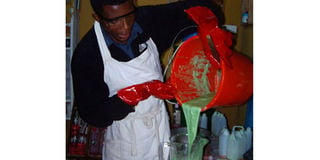Making bar soap is easy and profitable

You can make bar soap inside you kitchen, garage or backyard. File Photo
What you need to know:
As you search for which business you can engage in, it is time to think of making bar soap. Making bar soap is quite easy yet profitable. Get on the bus and make that investment. It will definitely a difference in your life, writes Dorothy Nakaweesi.
You have searched for what business to do but still failed to find something suitable.
To start a business that is not capital intensive and quick to master, is something you need and it is not out of reach.
How about trying to make bar soap? Yes, it sounds hard yet so easy if you put in that cup of commitment.
Ideally, bar soap is one of the most popular forms of soap in Uganda. It is a low cost cleaning agent that you will find in most homes in Uganda.
It is made from salts of vegetables or animal fats.
Therefore, the fact that it is used by most people in Uganda, it is a fast moving consumer good that will fetch you some good money yet it is not capital intensive.
Just like candles, bar soap is easy to make and today we shall focus on how you can start producing bar soap from your backyard, garage or kitchen.
It is one of those items that are a must buy in every household thus demand is widely spread and not limited to a certain class of people.
According to Newton Buteraba, the House of Wealth of chief executive officer, a business advisory services firm, starting a bar soap business requires low investment capital but has good returns.
However, he says, it would be appropriate that you first attain some skills before you start out.
A number of organisations such as Uganda Industrial Research Institute, have soap apprenticeships, which can help to kick start you.
Maria Kibuuka has been making bar soap for about a year now having started with only Shs300,000.
Just like many small scale businesses, bar soap makers, Kibuuka says operate the business as a cottage industry that mainly operates in her kitchen.
With the Shs300,000, you will buy a number of ingredients that are necessary in the production of bar soap.
To start with, you will need to buy caustic soda, one of the main ingredients, which costs about Shs80,000 on the open market.
You will also need 20 litres of palm kenol oil, which costs about Shs140,000 as well as perfumes of about Shs20,000.
However, you will also need some molding trays which will cost you about Shs50,000.
With these you will be good to go and from these you will be able to make about 180 bars of soap each weighing at least 120 grammes.
On average bar soap costs Shs3,000, which means that if you sell all the 180 bars, you will earn Shs540,000.
This means that, if you sell all the soap in one week, you will make a profit of Shs240,000 and a monthly profit of Shs960,000, which will translate into Shs11.5m in a year.
Expanding
You can expand by buying a fabricated bar soap machine in Katwe, Kampala. However, these are for small scale industry villages.
According to Buteraba, just like other businesses, it is important to have a workable and good business plan to enable you grow not only in quality but quantity and income.
“A good business plan is the working manual every entrepreneur needs to start and grow his or her business,” he says.
Therefore, he says, it is important to have one and must clearly state how you hope to achieve the targets that you have set.
According to Buteraba, however, you must seek continuous training as it will help you to know the kind of raw materials to use, the right measurements and understand what your target market needs.
How to make bar soap
Ideally, the production process starts with mixing of the oil-lye (sodium hydroxide- a reagent used to create soap from oils and water).
When the ingredients are blended into e a creamy mixture, you continuously stir as you add colour to the liquid.
Use a separate containers to dissolve a few drops of oil with a little of the blue and yellow coloring powder.
Stir each of the content until when it is blended into a single colour. Then mix together the dissolved powder in one container. The two will produce an olive green color, which you should set aside to cool.
Go back to the oil-lye mixture in the mixer and test its consistency by using a chopstick or bamboo stick.
When the oil-lye mixture is already creamy, add the aloe-vera essence or any other herbs you want to serve the purpose and spring fragrance.
Then add the remaining additives, after you have transferred the mixture into the molds and make sure the soap mixture is evenly distributed.
Allow the soap to harden for two to four and slice it by using a piece of string or a blunt object.




